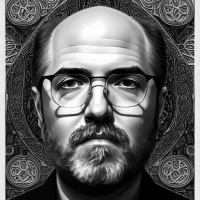The Battlestar Galactica Finale Was Good: So Say We All!
Even fans of Battlestar Galactica overall have problems with its three-part finale, but seen in the correct context, the ending works.
Battlestar Galactica has earned its spot in the science fiction television hall of fame alongside the likes of Star Trek, The X-Files, and other juggernauts of the genre. Some choose to ignore the series ending as an unfortunate aberration in an otherwise stellar space drama that remains one of the best franchise reboots to this day. But despite the plot holes regarding the cylons’ true motives among other flaws, the open-ended nature of the ending, especially for Starbuck, Baltar, and Six, needs to be viewed through the lens of what made this series great to be truly appreciated: its metaphysics.
Viewers need not have a religious bone in their body to appreciate the cultural depth of Battlestar Galactica. The rich social structure on the various ships of the Colonial Fleet alone was enough to put the series in its own category. The plight of workers during water shortages, the concentration camp atmosphere of New Caprica, and the politics of military versus administrative leadership were only part of the tapestry. The religion of the monotheistic cylons and the human belief in historical cycles played an equally important part in the rich world explored in the four seasons that led to the finale.
Once you accept the assertion that “All this has happened before and will happen again,” the metaphysical floodgates are open. Whether you call it fate, God, or historical and technological inevitability, the fact that the created become creators, birthing machines that question their own existence and purpose, is a philosophical arc that deserves a multitude of possible interpretations and debatable points of view. How could the series NOT end with a purposely vague ending encouraging faith and differing conclusions for each viewer?
Those who want answers to mysteries such as the future role of the hybrid child of Helo and Athena need only focus on the implications of the creator and the created coming together as part of the larger cycle, not on beginnings, middles, and ends for the characters involved. Do we need answers, for example, about the fate of D’Anna, the Number Three who stayed behind on the wasteland of the original Earth? No, and we shouldn’t want them. The enjoyment comes from wondering.
Likewise, the genius of the Battlestar Galactica ending was in letting the viewers decide for themselves whether Baltar and Six were angels, demons, or something else entirely. Do they meddle because they hope for a different conclusion as the final moments of the series suggest? Or do they merely mention the possibility so that the audience can either take the optimistic or pessimistic view of humanity’s fate in this cycle?
Similarly, Kara Thrace had a role to play, and the mysterious nature of her continued existence past her sacrificial death is no more inscrutable than the dogma of our own world religions. Was it even Starbuck at all that returned to the Galactica? Some see her as a ghost, but it could be a spirit that carried out its role in the continuation of the cycle either in spite of or because of Kara’s death. She disappeared in the end, which is where the questioning of her true nature really begins. Something mystical had to happen so that she could be seen as something truly more. That’s why it works!
Some viewers don’t like metaphysics in their science fiction; just look at the similar controversy surrounding the finale of ABC’s Lost. That’s fine. But the nature of the Battlestar Galactica ending should be a matter of taste, not a question of validity or effectiveness. The three-part finale works if you acknowledge what it was trying to accomplish. You may not like it, but that just means it wasn’t for you. And just remember: “So say we all!” sounds a lot like an “Amen!”
